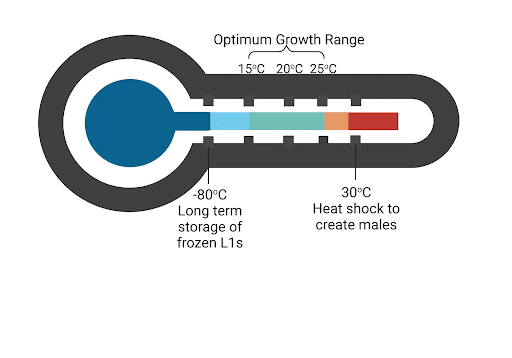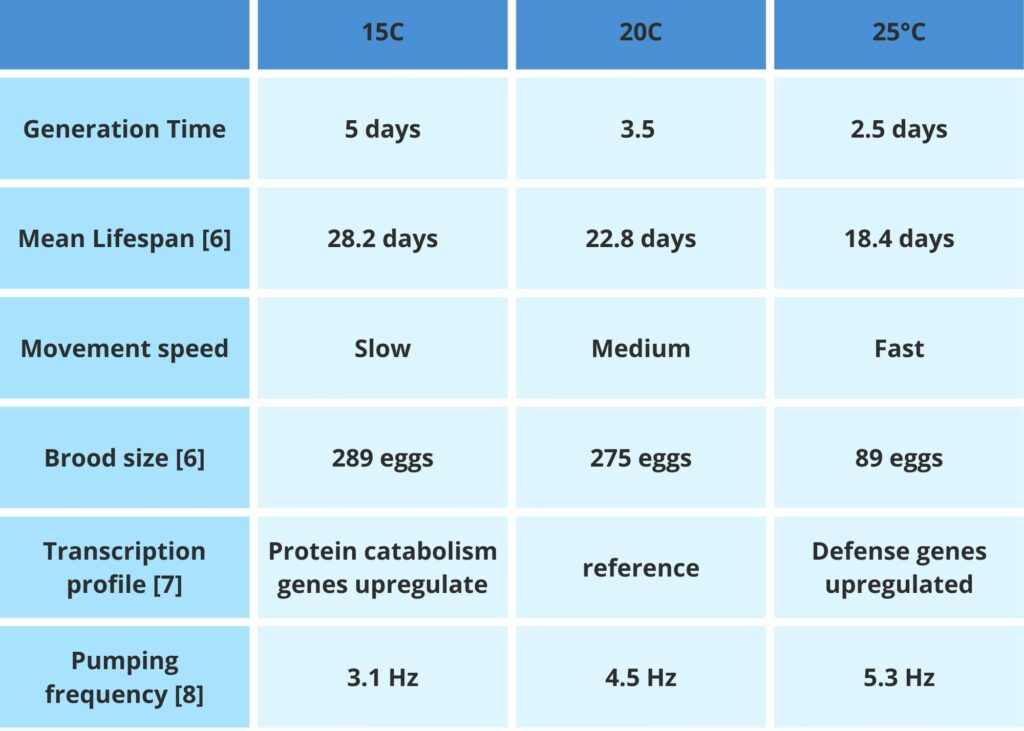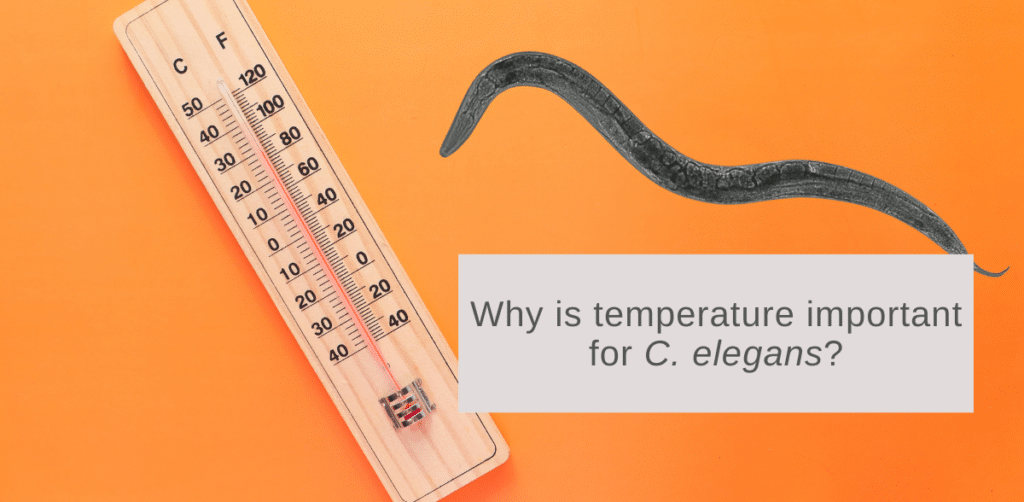Summary:
The standard growth temperatures for C. elegans in the lab range between 15°C and 25°C [Figure 1]. While this only spans 10 degrees, the difference in temperature has a huge impact on key worm characteristics such as growth rate, aging, reproduction, and size that are commonly measured phenotypes. In this article we will discuss the effect temperature has on our favorite worms, and how we can exploit these effects when designing studies.

Figure 1. Temperature range and its effect on C. elegans (created with BioRender).
We all know people who come alive in the winter-time and crave the snow, and, on the other end of the spectrum, the people who seek warmer weather – well, C. elegans also display temperature preference. C. elegans are ectothermic, meaning they do not produce their own body heat. They are also poikilothermic meaning their internal temperature varies with the environment. Thus, they are very sensitive to external environmental temperature. Although C. elegans cannot change their internal body temperature, they do adapt to the environmental temperature with changes in physiology, gene expression and behavior.
These small worms prefer the temperature that they have experienced in their past and will move to that temperature when placed on a gradient [5]. This is known as thermotaxis and is a way for scientists to study memory and environmental sensing in a simple model organism.
How does temperature impact worms?

Temperature & Stress
Response to temperature stress is another commonly measured phenotype for C. elegans. Severe cold stress (2-4°C for 24-48 hours) is lethal to the worms, but increased sensitivity or resistance to this stress can be observed. For example, worms lacking the hormone-sensitive lipase HOSL-1, are more sensitive to cold temperatures [1]. This sensitivity is likely due to the role of hosl-1 in fat mobilization and glycerol accumulation that protects worms from cold stress.
Although adult worms do not survive severe cold stress, scientists can use cryoprotectants to store larval worms at ultra-low temperatures (-80°C to −196°C) and revive them years later [1]. This is an incredibly useful aspect of C. elegans which allows scientists to preserve important strains with different genetic backgrounds. For example, the Caenorhabditis Genetics Center (CGC) preserves over 23,000 strains that are available upon request to researchers around the world [2].
In addition to extreme cold, high-temperature stress (>35°C) is also lethal to worms. Upon exposure to heat stress, expression of the heat shock proteins is upregulated. These proteins are molecular chaperones that promote protein folding and inhibit aggregation which is important for survival at elevated temperatures. Consequently, scientists have been able to use this dramatic increase in expression as a method for conditional gene expression [3]. The target gene is controlled by the heat shock promoter, under standard conditions (20°C) the gene will not be expressed; however, when the animals are exposed to heat (33°C for 1 h) expression is activated.
Temperature can also be used to induce males in the C. elegans population. Males can be used for genetic crosses and phenotyping assays. Treating hermaphrodite L4s with heat stress of 30°C for 6 hours leads to an increase in the incidence of males in the next generation due to chromosomal nondisjunction [4].
How do you choose the temperature to use?
- 20°C is the most common temperature for growth and assays.
- Temperature-sensitive mutations will have specific growth temperatures.
- Temperature can be used to control growth rate (speed up/slow down).
- 25°C is a good temperature to maintain array expression (avoids germline suppression).
Conclusion
While there is no single, ‘correct’ temperature that C. elegans researchers ought to use in their studies, temperature is an important consideration when designing an experiment. Knowing how the higher and lower ends of the standard temperature range can impact C. elegans‘ development can give researchers insight into their model organism, and can even be intentionally manipulated to perform a more sensitivity study. Tired of dealing with unreliable gene editing techniques? Our experienced team can take over and deliver the results you need through our gene editing services. We welcome the opportunity to discuss your project with you.
Glossary:
- Ectothermic = organism does not produce their own body heat
- Poikilothermic = organism’s internal temperature varies with the environment
- Thermotaxis = small worms prefer the temperature that they have experienced in their past and will move to that temperature when placed on a gradient
References:
- Liu F, Xiao Y, Ji X-L, Zhang K-Q, Zou C-G. The cAMP-PKA pathway-mediated fat mobilization is required for cold tolerance in C. elegans. Sci Rep. 2017;7: 1-10.
- Caenorhabditis Genetics Center (CGC) – College of Biological Sciences. [cited 18 Feb 2022]. Available: https://cgc.umn.edu/
- Fire A, Harrison SW, Dixon D. A modular set of lacZ fusion vectors for studying gene expression in Caenorhabditis elegans. Gene. 1990;93. doi:10.1016/0378-1119(90)90224-f
- Anderson JL, Morran LT, Phillips PC. Outcrossing and the Maintenance of Males within C. elegans Populations. J Hered. 2010;101: S62.
- Takeishi, Asuka, Takagaki, Natsune & Kuhara, Atsushi (2020). Temperature signaling underlying thermotaxis and cold tolerance in Caenorhabditis elegans, Journal of Neurogenetics, 34:3-4, 351-362, DOI: 10.1080/01677063.2020.1734001
- Lee, S. J., & Kenyon, C. (2009). Regulation of the longevity response to temperature by thermosensory neurons in Caenorhabditis elegans. Current biology : CB, 19(9), 715-722. https://doi.org/10.1016/j.cub.2009.03.041
- Gómez-Orte E, Cornes E, Zheleva A, et al. Effect of the diet type and temperature on the C. elegans transcriptome. Oncotarget. 2017;9(11):9556-9571. Published 2017 Dec 21. doi:10.18632/oncotarget.23563
- InVivo Biosystems data



